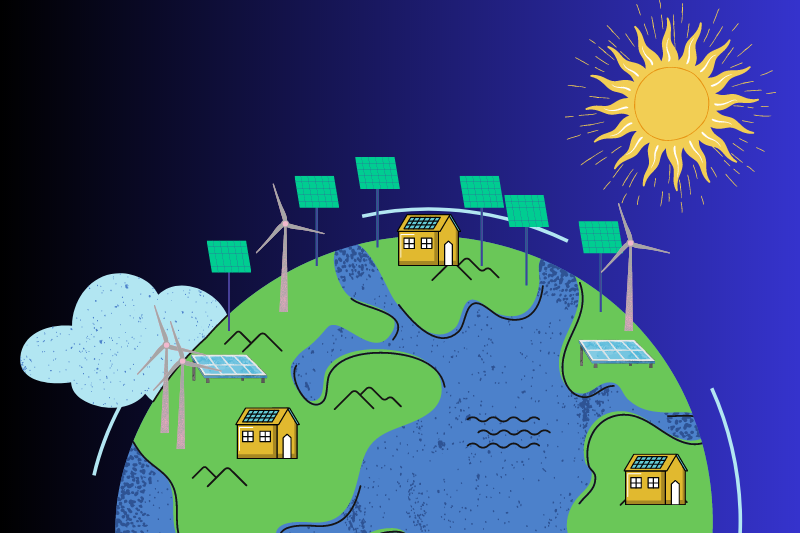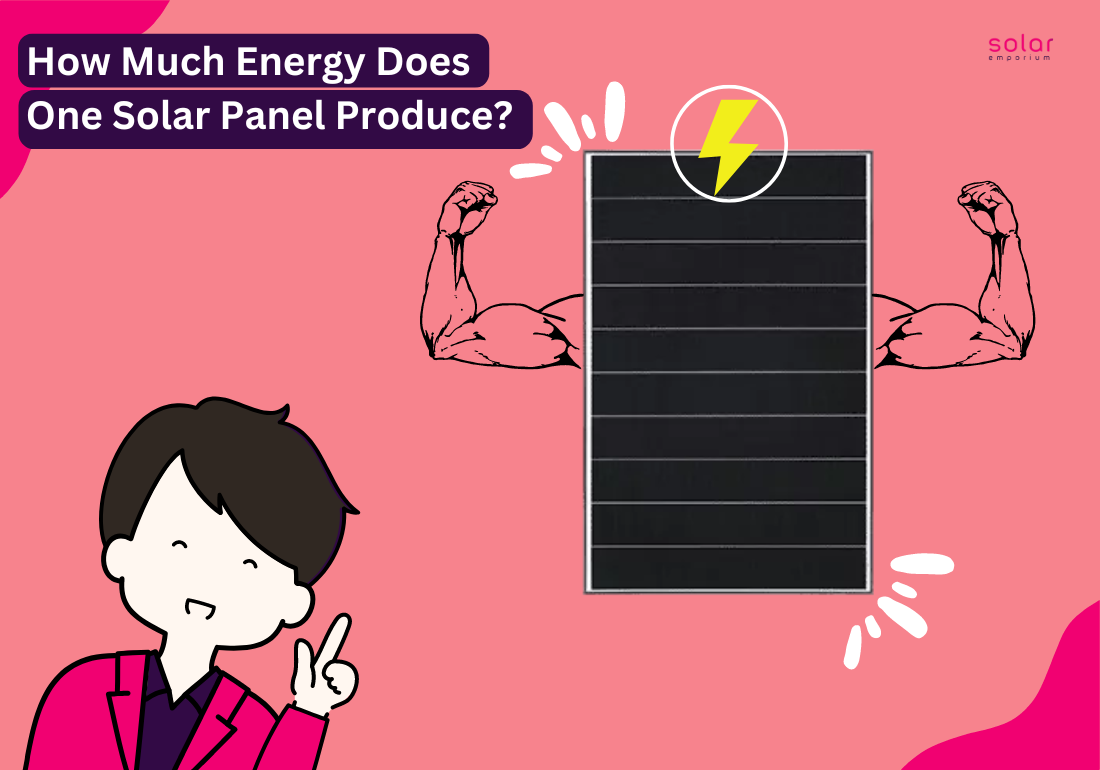Everybody wants to generate electricity from solar energy. However, a key remains amongst the people. How much power does one solar panel produce?
This information is vital for households and enterprises considering transitioning to this green energy alternative. Today we will explore solar panels and solar energy production in Australia.
Key Factors to Know
Before determining how much power a solar panel generates, you must understand a few basic terms.
- A kilowatt (kW) is a unit of electrical power equal to 1000 watts.
- Kilowatt Hours (kWh) – the amount of electrical energy consumed in one hour equals 1000 watts.
- Direct current power (DC) is the energy generated by a solar panel.
What is the Output of a Solar Panel?
The amount of DC power solar panels produce under ideal conditions is used to rate them. It is measured in watts (W) and represents the power your panels can have.
Most residential solar panels have power ratings ranging from 250 to 400 watts, with higher power ratings preferred over lower ones. Under the same conditions, higher-wattage solar panels generate more electricity than lower-wattage panels.
The Technology of Solar Panels
To fully comprehend solar panel output, you must first understand the type of panels used. Solar panels are classified into different types. But the most marketed are monocrystalline and polycrystalline.
Monocrystalline panels produce more energy efficiently. They do, however, have higher initial costs. In warmer temperatures or shaded areas, monocrystalline panels produce more solar energy.
Polycrystalline panels are less efficient than monocrystalline panels but are also less expensive. They also perform less effectively at higher temperatures.
Choosing the right solar panel for your home will help you maximise efficiency. You can use the sun’s power with an efficient, high-quality solar panel.
Maximising Solar Panel Efficiency in Australia
To maximise the energy output of your solar panels, consider the following factors:
Panel Position: Solar panels should be installed facing north for optimal sunlight exposure in Australia.
Tilt Angle: The tilt angle of your solar panels can also impact their efficiency. A tilt angle equal to your latitude is generally recommended.
Shade: Ensure your solar panels are not shaded, as this can significantly reduce their energy output.
Maintenance: Regular cleaning and maintenance can keep your solar panels at peak performance.
Understanding solar panel energy production is key to maximising the benefits of this renewable energy source. With Australia’s favourable climate, solar energy is a viable and sustainable power solution for many households and businesses.

Considering panel position, tilt angle, and maintenance, you can optimise your solar panels’ efficiency and contribute to a greener future.
While the energy output of a single solar panel can vary, it’s clear that solar panels can significantly reduce reliance on traditional energy sources and contribute to a greener future.
Long-term savings on energy bills can offset the initial investment in solar panel installation. So, if you’re considering switching to solar energy, now is a great time to take advantage of Australia’s sunny climate and harness the sun’s power.
Understanding Solar Panel Energy Production
Solar panels convert sunlight into electricity, a process known as photovoltaic effect. The amount of energy a solar panel produces depends on several factors, including size, efficiency, and exposure to sunlight.
Solar panels can generate significant power in Australia, where the sun shines on average over 2800 hours per year.
Australia is an ideal location for solar energy production. As more Australians embrace renewable energy, understanding solar panel energy production becomes increasingly important.
The amount of energy a solar panel produces depends on its size, efficiency, and exposure to sunlight. A standard solar panel of about 1.6 square meters in Australia can produce around 300 to 370 watts per hour under optimal conditions.
Let’s delve into solar panel energy production basics, shedding light on this fascinating technology.
The Science Behind Solar Panels
Sunlight to Electricity
The electricity generated by solar panels is direct current (DC), which must be converted into alternating current (AC) for most homes and businesses.
This conversion is done by a device called an inverter. Once converted, the electricity can power appliances, charge electric vehicles, or be stored in a battery for later use.
Maximising Solar Energy Production
The amount of energy a solar panel produces depends on several factors, including its size, efficiency, and the amount of sunlight it receives.
Solar panels should be installed in a location with plenty of sunlight to maximise energy production. North-facing solar panels are ideal for Australia. The tilt angle of the panels can also be adjusted to capture the most sunlight throughout the year.
Storing Solar Energy
The Environmental Impact

Solar panel energy production is clean and doesn’t emit harmful greenhouse gases. By switching to solar energy, households and businesses can significantly reduce their carbon footprint, contributing to a more sustainable future.
Understanding the basics of solar panel energy production can help you make informed decisions about adopting this renewable energy source.
This knowledge is key to using the sun’s power, from the science behind solar panels to the factors that maximise their energy production. Solar panels are ideal for a sustainable future with their environmental benefits and potential for significant energy savings.
Energy Production of a Single Solar Panel in Australia
As more Australians turn to renewable energy sources, understanding the energy output of a single solar panel becomes increasingly important.
As mentioned before, A standard solar panel in Australia typically produces around 300 to 370 watts of power per hour under optimal conditions. It is approximately 1.2 to 1.48 kilowatt-hours (kWh) of energy per day.
However, these figures are based on peak sunlight hours, which can vary across different parts of Australia.
On average, a standard solar panel in Australia, with a size of about 1.6 square meters, can produce around 300 to 370 watts of power per hour under optimal conditions. A solar panel can generate approximately 1.2 to 1.48 kilowatt-hours (kWh) of energy daily.
Understanding the energy output of a single solar panel is crucial for anyone considering a switch to solar energy in Australia.
With the country’s favourable climate and abundant sunshine, solar panels can significantly reduce reliance on traditional energy sources and contribute to a greener future.
Long-term savings on energy bills can offset the initial investment in solar panel installation. So, if you’re considering switching to solar energy, now is a great time to take advantage of Australia’s sunny climate and produce solar energy.
Calculating the Energy Produced by a Solar Panel
The amount of direct current (DC) power solar panels produce under normal conditions is rated. The output of a solar panel is measured in watts (W) and represents how much power it can make under ideal conditions.
Most residential solar panels today have a power output rating of 250 to 400 watts. Because solar pricing is frequently measured in dollars per watt, the total wattage of your solar panels is an important component of the overall cost of your solar system.
To calculate solar panel output, use the following formula: hours of sunlight x wattage of your solar panel.
Benefits of Solar Energy for Australians
Australia, the sun-soaked continent, is increasingly popular for the power of the sun to fuel its future. Solar energy, a clean, renewable, and abundant power source, transforms how Australians live and work.
Some benefits are mentioned below to inspire more Australians to join the sustainability revolution.
Significant Cost Savings
Energy Independence
Job Creation
Environmental Sustainability
Solar energy is a clean, green source of power. Australians reduce their carbon footprint by using the sun’s power and contribute to a more sustainable environment. Solar energy produces no greenhouse gas emissions, making it a key player in Australia’s efforts to combat climate change.
Increased Property Value
Installing solar panels can increase the value of a property. According to a study by the University of Melbourne, homes with solar panels sell for 3.8% more on average than comparable homes without solar. This makes solar energy an environmental investment and a smart financial decision.

Government Incentives and Rebates
The Australian government offers a range of incentives and rebates to encourage the use of solar energy. These include the Small-scale Renewable Energy Scheme, which provides certificates that can be sold to recoup a portion of the cost of installing solar panels.
This makes solar energy an even more attractive option for Australians. From significant cost savings to environmental sustainability, the benefits of solar energy for Australians are clear.
As the country continues to harness the sun’s power, these benefits are set to grow, making solar energy an increasingly important part of Australia’s energy future.
With the government’s support and the industry’s growth, the sun shines brightly on Australia’s solar energy landscape.
How to Ensure Your Solar Panels Are Working Efficiently?
The solar panels are linked to a control panel known as an in-home display. This wireless device can determine whether your system is producing enough electricity.
If you suspect that your solar panels are underperforming, get in touch with the installer or manufacturer. They have the option of dispatching a professional technician to investigate.
We never recommend tampering with the solar panels because it can damage the system and void your warranty. Contact Solar Emporium for any solar advice or solution.







